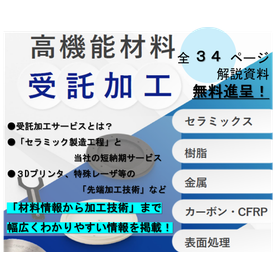Introduction to Carbon Fiber Reinforced Plastic Pitch Type 'CFRP'
Introducing the pitch-based "CFRP," which is lightweight, highly rigid, excellent in vibration damping, and combines high thermal conductivity with low thermal expansion.
CFRP is broadly categorized into two types: "PAN-based" and "pitch-based." Our company recommends "pitch-based" CFRP. Compared to PAN-based CFRP, pitch-based CFRP excels in tensile modulus (stiffness) and is particularly suitable for stiffness design applications. (PAN-based CFRP excels in tensile strength and is often used for strength design applications.) 【Heat】 In terms of heat resistance, there are special grades ranging from 80°C to a maximum of 250°C, with a coefficient of thermal expansion lower than that of ceramics and high thermal conductivity grades exceeding 100W. 【Vibration】 It has excellent vibration damping properties, and significant effects can be expected for forks used to transport heavy objects compared to metal. It exhibits outstanding performance in both self-weight deflection and load deflection when carrying workpieces. Because deflection can be minimized to the extreme, it is also possible to transport forks into narrow openings. 【Stiffness】 Due to the high tensile strength of PAN-based CFRP, it is often used in passenger aircraft, wind power generation, and automotive parts. Pitch-based CFRP can control the modulus of elasticity over a wide range, achieving high stiffness, and is widely used in satellite components, antennas, and robotic hands. We can design based on the customer's usage conditions. Please feel free to contact us first.
basic information
CFRP is broadly categorized into two types: "PAN-based" and "pitch-based." Our company recommends "pitch-based" CFRP. Pitch-based CFRP excels in tensile modulus (stiffness) compared to PAN-based CFRP, making it particularly suitable for stiffness design applications. (PAN-based CFRP excels in tensile strength, making it more suitable for strength design applications.) "PAN-based" Polyacrylonitrile, a chemical fiber, is carbonized and graphitized. There is a limit to crystallization even when the graphitization temperature is increased. Density is approximately 1.8. "Pitch-based" Using petroleum-based and coal-based pitch as raw materials, it is spun, carbonized, and graphitized. By increasing the graphitization temperature, higher crystallization is achieved. Density is approximately 2.1. As a special specification, fluorine coating on CFRP is also possible (with heat resistance limitations). Please feel free to contact us.
Price range
Delivery Time
Applications/Examples of results
- Semiconductor manufacturing equipment - Wafer transport robot - LCD glass transport robot - Satellite components - Automotive parts - Transport rollers - General industrial use
catalog(1)
Download All CatalogsNews about this product(1)
Recommended products
Distributors
Narasaki Sangyo Co., Ltd. "Functional Materials Division" specializes in high-performance material contract processing. The materials we handle fall into "five categories": 1. Ceramics/Glass 2. Metals 3. Engineering Plastics 4. Carbon 5. Surface Treatment We offer a wide range of services, and if you provide us with a single production drawing, we can deliver various materials and surface treatments as a one-stop solution. We cater to everything from general-purpose to specialty materials, including high-precision, fine, electrical discharge, laser processing, as well as surface treatments such as coating, precision cleaning, and blasting. Our particular strength lies in high-precision and short-lead-time processing of ceramics. By machining from pre-fired materials, we achieve short lead times for ceramics that traditionally take several months. We handle a wide range of ceramics, including machinable ceramics like Hotovel, as well as fine ceramics such as alumina and zirconia, and non-oxide ceramics like silicon carbide, silicon nitride, and aluminum nitride. We are also actively engaged in proposing cost reductions for overseas ceramics and other international materials. We can accommodate various contract processing projects, from prototype development starting with a quantity of one to mass production.








